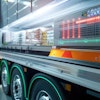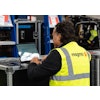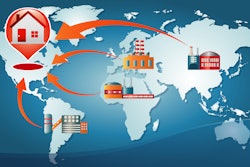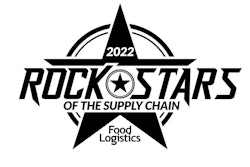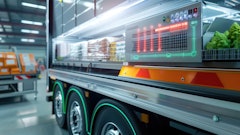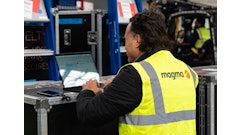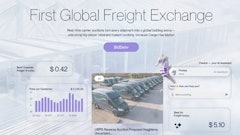
Discussions about supply chain sustainability have taken center stage in recent years, forcing organizations to rethink the practices responsible for their carbon footprints. Indirect emissions, which are created by supply chain activities like transportation and distribution, comprise up to 90% of an organization’s greenhouse gas (GHG) emissions each year, and the amount of GHGs will continue to rise unless action is taken.
Supply chain disruption is closely linked to GHG emissions, but only when supply chain operations are inefficient. Disruptions frequently delay a project, requiring additional energy and resources. If an organization is not able to prepare for or mitigate a delay, such a disruption can harm their bottom line. Unfortunately, disruption can always be around the corner, from shifts in demand and severe weather to pandemic-driven interruptions such as materials shortages.
The issue is even more complex for professionals in the cold food and beverage supply chain, which is complicated by the logistics of distributing, storing and transporting temperature-controlled products. For enterprises that touch the cold chain, reducing their carbon footprints begins with creating more efficient and sustainable supply chains.
The disruption-prone cold chain is unsustainable
Food systems across the globe account for one-third of human-produced GHG emissions each year, primarily stemming from activities along the supply chain. In each product lifecycle, operations related to fuel and energy consumption, the processing of goods and transportation are continuously emitting gasses into the atmosphere. Cargo transportation alone accounts for 10% of annual global GHG emissions.
The carbon footprint of these activities grows when the supply chain is interrupted. Disruption frequently results in delayed or extended project timelines, which inevitably means organizations must pour additional energy and resources into the project.
For example, when an unforeseen winter storm slammed Texas in February 2021, it created a domino effect of supply chain turmoil and unsustainable operations. During this time, warehouses had to store excess inventory, manufacturing operations stopped and poor road conditions created long lead times, meaning trucks used more fuel than normal. Additionally, cross-border shipments that ordinarily take a day required at least 2-3 days. Although these issues can occur in any supply chain, cold chains require different energy-intensive processes and face additional challenges in maintaining food freshness and quality.
Cold chain professionals face a double challenge: They need temperature-controlled storage and distribution for food and beverage products, which are costly and can create a significant carbon footprint. But the cold chain is also fragile. From the moment a food product is harvested or manufactured, there’s a risk it can reach unsafe temperature during transit or distribution. When disruptions occur — if operations are inefficient or workers are unprepared — food and beverage products spoil and must be thrown away.
The food waste that stemmed from the Texas winter storm disruptions in 2021 was valued in the millions of dollars, including items thrown away due to transportation issues. Food waste also presents a significant environmental concern because when you waste food, you also waste the water and energy it takes to grow, package, and transport it.
The bottom line? To reduce GHG emissions from the supply chain, enterprises need to embrace more sustainable practices.
4 ways an ERP system can boost efficiency and sustainability
Sustainability and profitability in the supply chain are linked, but only with information technology such as enterprise resource planning (ERP). ERP enables organizations to operate more efficiently by using real-time information for insights into operations.
Here are several ways ERP can help organizations create more efficient operations and reduce their carbon footprints.
- Make more accurate predictions. Predictive analytics use machine learning, artificial intelligence (AI) and statistical algorithms to analyze internal and external data. The resulting insights can be stored in a cloud-based ERP system to forecast future trends more accurately, such as a time of year when a certain food product is not in high demand. As a food supplier, this helps you scale back accordingly to avoid food waste.
- Coordinate more accurate shipping routes. Predictive analytics can be deployed to optimize trucking and cargo shipping routes. When unexpected disruption occurs, such as traffic or severe weather, real-time data is the key to optimized routes. AI paired with route optimization software enables real-time rerouting while collecting data to inform future decisions. By determining the most efficient shipping routes, organizations can reduce fuel usage and prevent perishable items from spoiling by delivering orders in a timely manner.
- Increase visibility with operational insights. A lack of real-time visibility is a key contributor to operational inefficiency. But sensor technology such as Internet of Things (IoT) devices can be connected to an ERP system for real-time information about each point in the supply chain. Picture this, a loading dock is backed up and cannot handle its next scheduled shipment. However, the transportation team in charge of the shipment is not aware of this, so they arrive at the dock with a cargo ship full of perishable goods. This further congests the port while the perishable goods spoil due to warm temperature exposure. If each party along a supply chain has access to real-time updates, this type of situation can be avoided.
- Measure sustainability KPIs. Enterprises along the supply chain have started to build sustainability KPIs into their ERP systems to calculate and record the environmental impact of business initiatives (e.g., greenhouse gas emissions per unit of revenue). Documenting these types of KPIs not only helps identify areas of improvement in terms of sustainability, but also helps you sell products. Clearly labeling products with consumer-friendly sustainability KPIs is an effective selling point considering 73% of U.S. consumers factor a product’s sustainability into their purchasing decisions.
Conversations around supply chain sustainability are not going away anytime soon. Enterprises need to take a step back and rethink how their activities are impacting their carbon footprints, especially organizations that operate along the cold chain. Ultimately, creating more sustainable supply chain operations not only reduces your carbon footprint — it also positions your business for long-term efficiency and success.

